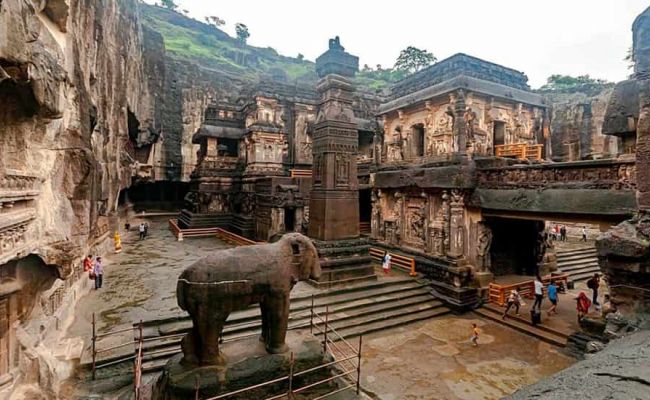The Ellora Caves, located in Maharashtra, India, are a spectacular complex of rock-cut temples and monasteries that exhibit a distinct blend of religious harmony, artistic quality, and architectural intricacy. Carved between the sixth and tenth centuries, these caverns represent three major religions: Buddhism, Hinduism, and Jainism, and serve as a witness to India’s rich cultural and religious heritage.
History
The invaluable ensemble of 34 caves at Ellora in the Charanandri hills of western India’s Maharashtra State exemplifies a spirit of coexistence and religious tolerance through outstanding architectural activities carried out by followers of three major religions: Buddhism, Brahmanism, and Jainism.
From the sixth to the twelfth centuries, there were three stages of rock-cutting activity. The earliest caves (caves 1–12), excavated between the 5th and 8th centuries, reflect the Mahayana doctrine of Buddhism that was dominant in this region. The 7th and 10th centuries saw the excavation of the Brahmanical series of caverns (caves 13–29), which includes the well-known Kailasa temple (cave 16). The final phase, which lasted between the 9th and 12th centuries, involved the excavation of a complex of caverns (caves 30-34) that reflected Jaina philosophy.
Among the Buddhist caves, Cave 10 (Visvakarma or Sutar-ki-jhopari, the Carpenter’s Cave), Cave 11, and Cave 12 (Teen Tal, or three-story monastery, the largest in this category) are especially significant. These caverns symbolize the evolution of the Vajrayana school of Buddhism and house a plethora of Buddhist deities. The Brahmanical group’s notable caves include Cave 15 (Dasavatara, or Cave of Ten Incarnations), Cave 16 (Kailasa, the largest monolithic temple), Cave 21 (Ramesvara), and Cave 29 (Dumar Lena). Among these, Cave 16 is an excellent example of structural innovation, representing the pinnacle of rock-cut architecture in India, with intricate workmanship and striking proportions. Some of India’s boldest and greatest sculptural masterpieces embellish the temple.
The sculpture representing Ravana attempting to lift Mount Kailasa, Siva’s sanctuary, is particularly significant. The ceilings of this temple’s entrance mandapa (pillared hall) contain the remains of exquisite murals from several periods. The Jaina caves (caves 30-34) showcase superb, delicate sculptures and murals dedicated to the Digambara sect. The Ellora Caves’ art and architecture provide a window into ancient India, revealing socio-cultural phenomena, material culture, politics, and lifestyles.
Integrity
Ellora Caves contains all of the elements required to demonstrate its Outstanding Universal Value, including architectural and sculptural aspects that testify to Buddhism, Brahmanism, and Jainism in a continuous series of monuments from AD 600 to 1000. The property encompasses both the ensemble and its natural context, ensuring a full representation of all elements and processes that express the property’s significance, free from the negative consequences of development or neglect. Identified possible threats to the property’s integrity include tourist and environmental management, seepage and cracking in the caverns, and the property’s conservation personnel capacity.
FAQ
The Ellora Caves were excavated and built between the sixth and tenth centuries AD; therefore, they are roughly 1,400 to 1,200 years old.
Cave 16, also known as the Kailasa Temple, is Ellora’s most famous cave. This cave is known for its gigantic size, complex carvings, and monolithic architecture devoted to Lord Shiva. People recognize it as one of the world’s largest and most stunning rock-cut temples.
